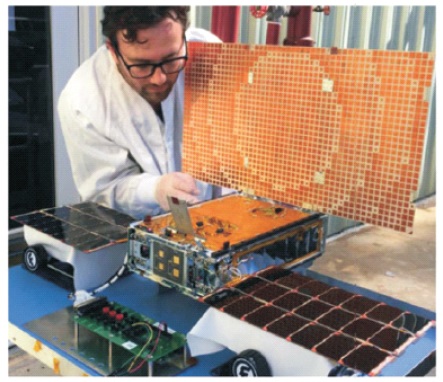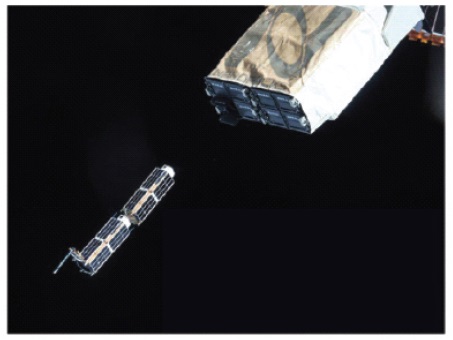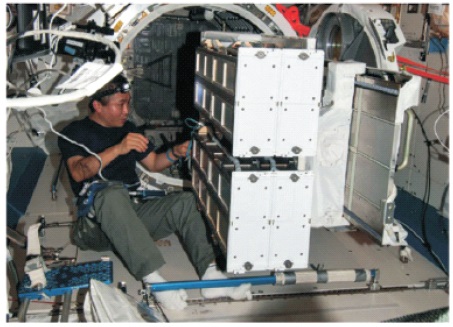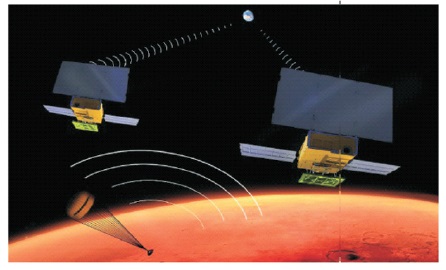
Figure 1. Kessler Syndrome: Garbage Orbiting Earth
Artificial satellites have revolutionized human civilization to get closer and know happenings around the world instantly. They communicate with the control station with details collected with the designated purposeful devices configured or installed or mounted as payloads. This article informs details on the construction of a nano satellite or CubeSat. Embedded technology has developed as a field where a standalone devise can be fabricated in a very small area/volume including its firmware. Embedded technology has invaded into every useful area of applications. Generally, the launched CubeSats have limited mission with limited objectives like, technology demonstration, amateur radio, earthquake detection, biological research technology demonstration, gamma ray detector, measuring the effect of antifungal counter measures on yeast strains in microgravity, ionospheric research, radiation effects on bipolar-transistor-based circuits, earth imaging and space environment measuring, deployable membrane technology demonstration, infrared camera imaging, orbital debris and small asteroids monitoring, demonstrating increased orbital energy with controlled solar sailing in Earth orbit, monitoring Green house gases, and much more. Modules made using embedded technology for specific and creative solutions can be payloads in CubeSats. Colleges and students have the possibility to launch their own satellites, as their own experiments – testing technologies and helping humanities.
On October 4th, 1957, the space age began for humanity. On this day, the earth’s first artificial satellite was launched - the Soviet Sputhik-1. Thousands of designers, engineers, and scientists worked on this task for almost ten years. Today, even school children are capable of launching an orbital satellite, and we will tell you how to do so.
If you want to do something space-related, then you can begin with satellites, albeit small ones. Engineers classify them by weight: mini-satellites (up to 500 kg), microsatellites (up to 100 kg), nano-satellites (up to 10 kg), picosatellites (up to 1 kg), and femto-satellites (up to 100 g). Regardless of the miniature size and weight, small spacecraft solve many problems, often complementing large satellites and in some things even replacing them. First of all, these little ones are needed for observation and filming of the planet —remote exploration of the Earth. Secondly, they provide Internet connections in places where there are no relay towers. Thirdly, new technologies are tested and experiments are conducted on small satellites. All of this is possible due to the relatively low cost of these crafts — from a couple thousand to several tens of thousands of dollars. As a result, many universities and enthusiasts have their own cosmic devices. In total, more than 1,823 satellites have been launched, 587 of which are still in orbit.
The launch of a small satellite doesn't require special qualifications or large monetary expenditures. In addition, you can use available technological devices which are developing every day. This is easy to see, for example, with mobile phones. So, with modern satellites it's possible to install a huge number of sensors and devices, beginning with antenna and ending with spectrometers.
If you are going to launch a satellite, you need to think about the task you would like to solve. On the Internet, you can find organizations and enthusiasts who have the experience you need and can tell you what to do. Your goal should be completable and well thought-out, so the craft is useful and doesn't just become garbage in orbit (Figure 1). Thoughtless launches bring the so-called Kessler Syndrome closer — a situation in which space garbage in near-Earth orbit will make near space entirely unsuitable for practical use. This phenomenon is named in honour of the NASA consultant, Donald Kessler, who first described this problem.

Figure 1. Kessler Syndrome: Garbage Orbiting Earth
Launching a satellite on your own will be difficult. Therefore, immediately look for like-minded people — you can put something out on social media, on specialized forums, or in universities where there are aerospace programs. There are even summer space camps that exist, where the team of your dreams is already assembled in full. For the construction of a satellite, you will need designers, electronics engineers, programmers, and specialists in ballistics and in the experiments which you plan to conduct in orbit. Don't forget about a manager — he will cooperate with businesses and will take over management of the project.
Not one spacecraft can be designed, built, and tested without technical specifications. This is the main document of the project, where everything is described: deadlines, purpose of creation, technical requirements, content (payload), strains which the craft must survive, testing conditions, materials (they should meet standards), stages for work completion, numerical characteristics which the satellite must meet, the distribution of tasks within the team, schedules, and so on. You'll show namely this document to your colleagues and will present it to the space agency in order to get permission to launch (Figure 2).

Figure 2. Working of Relay Satellites
The time has arrived to determine the satellite's parameters. Its shape, size, and many other characteristics depend on what its configuration and payload (scientific content) are. For a student craft, the nano-satellite format fits best, namely CubeSat, a cube with a size of 10 x 10 x 10 cm (Figure 3). The beauty of CubeSats is the design (Figures 4 & 6). The components — cubes — can be assembled, that is, put together and connected, in order to increase the number of compartments for equipment. As such, the size of CubeSat directly depends on the number of scientific problems your satellite will solve.

Figure 3. Standard Unit of CubeSat

Figure 4. Prototype of CubeSat

Figure 5. NEA Scout – Designed to Study Asteroid

Figure 6. Inside the CubeSat
It's necessary to understand which enterprises in the rocket and space field you should cooperate with and who can be useful for the realization of your project. It's possible that you will be able to build the satellite yourself, but further along, you'll need to test it and receive a license for Launch, and for this, it's necessary to work with space business organizations. Without their help, you won't get by; an experienced view from the outside, a good consultant, and preferably several, are necessary. Plus, as already said, the satellite, as a technically complicated object, must pass through a series of tests and approvals. For all of this, you need a base.
The creation of a nano-satellite is expensive but feasible. By various estimates, you'll need from $50,000 to $100,000. It's necessary to create a frame, buy electronic components, and pay for the work of specialists. Where are you to get this money? You can't ask your parents, and your friends won't be able to raise that sum. However, there are other variants. If the sum isn't very big, you can launch a crowdfunding campaign, as the creators of the Russian satellite “Mayak” did, or try to find an investor and convince him that your project is cool and also possibly profitable. You can apply for a grant from space organizations. You can perform an order for a private company, but you need experience for this. The cheapest and most simple variant is to make the satellite in an educational institution, for example in a university or school, or in a camp where there is a space session.
The modularity of components and the relative cheapness of small satellites will soon make their launch a publicly available form of entertainment. According to experts, in five to ten years, any school will be able to afford a satellite — and in twenty, any person.
Even now, one can order all of the components for a satellite to their home from a mobile phone. After the purchase of the components begins the main process — assembly (Figures 5, 7, 8 & 9). You need to rent an enclosure with equipment (for example, milling machines and 3D-printers). For this purpose, you can use university fablabs, laboratories, or at the end of the day, your grandfather's garage (the most important thing is to observe safety precautions!). Find an enclosure with equipment and construct the satellite. Just remember — a few sets of each piece are needed. Why? Some of them will be ruined in trials.

Figure 7. Technician in the Construction of a Nanosatellite

Figure 8. Engineers Install Temperature Sensors on Internal Components of a Satellite for the Testing of Field Conditions

Figure 9. Installation of Solar Panels on the mini-satellite Macro Cube Sate
Having received the document which says: "Tests Successfully passed, launch can proceed; you can begin the search for an operator-organization which will send your spacecraft into orbit” (Figures 10, 11, 12, 13 & 14). Keep in mind, the more it weighs, the more it costs. But, if the satellite is for educational purposes, you can avoid these expenses. Roscosmos, for example, has a program which provides for the free launch of several crafts commissioned by order of educational institutions of the Russian Federation.

Figure 10. A Serries of CubeSats Launched from ISS, with the Help of Special Device Mounted on the Japanese Experimental Module (JEM)

Figure 11. Japanese astronaut Koichi Wakata Prepares to Launch Cube Sats from ISS

Figure 12. NASA's EnaNa: Fourth Training Launch of 11 CubeSats into Orbit

Figure 13. Artist's Impression of Twin Satellites MarCO-A and MarCO-B Designated to Study the Structure and Compisition of Mars with Seismometer

Figure 14. The First Estonian Satellite ESTCube-1 is the First Satellite in the World which uses an Electric Sail
About a month before launch, you need to go to the spaceport in order to install the craft in a container. There are two variants for launching nano-satellites into orbit: launching them from a special container on a carrier rocket or by hand while astronauts aboard the ISS are working in open space. The majority of nano-satellites fly at the same orbit as the ISS (approximately 400 km, maximum 600). There are, however, two CubeSats (MarCO) which are flying to Mars. Small satellites are controlled with gyrodyne flywheels, used for stabilizing the device and preventing it from spinning. The trajectory can be changed by rotating the satellite: with its body, it is able to brake as well as speed up. On large satellites, the orbit is changed with the help of thrusters, but on small crafts, they are hardly ever used: for the time being, the technology of miniature thrusters isn't very well developed. However, there are CubeSats which move due to cold gas, chemical reactions or electronic force.
If the craft is ready, get to testing; whether a satellite will fly into space or not depends on them. This is how it usually happens: you build the satellite, test it, something breaks or a mistake is uncovered, and the process begins again. It's necessary to check if all systems work separately and as a whole, as the cost of a mistake is great. The design must withstand overstressing and vibrations which occur while entering orbit. This isn't just so the satellite doesn't fall apart, but also so that it doesn't lose contact.
On the vibration stand, the satellite is tested for overstressing (like during a real flight): vibrations, accelerations, shocks. Then thermo vacuum testing is carried out (this can last several days): the reception of information from the satellite is tested in a vacuum and with temperature changes on the contact surface. In parallel, the electromagnetic compatibility of the equipment can be tested. All of this is a very time-consuming process. You can Launch the satellite into the stratosphere; the conditions there are as close as you can get to space.
The happy day has arrived: the rocket has taken off, the satellite taken into orbit—you should be congratulated. What's next? In order for the satellite to transmit signals (Figure 2), you need to buy a certain radio frequency of a standard FM band from the Ministry of Communications. Many universities create a flight control centre within their walls — a special room with many large screens and workplaces where the craft's signals are received.
Let's say that everything goes as well as possible: the satellite has entered its calculated orbit, stabilized, turned on and started working. What do you do now? Having programmed the station to receive data at the needed time, sit and wait for when the craft flies by. Further, you'll receive and process signals. In other words, the team of engineers can breathe a sigh of relief — the scientists are taking over the watch. But this is a different story.
If your satellite doesn't start working in orbit (this can also happen), don't be sad! You launched a craft into space, and not everyone can boast of such an achievement. You need to gather as much launch data as possible and try to find the reasons for failure. After all, this is how the rocket industry develops — by learning from mistakes.
Embedded system technology is having the potential to grow with the increasing demand among space researchers in launching nanosatellites. Similar to Internet of Things (IoT), another emerging technology is Internet of Space (IoS), which will be embedded device in a 1” x 1” Printed Circuit Board (PCB) containing the essential radio receiver, gyroscope, ECC RAM, thermal sensors, etc. Small satellites carrying embedded systems are likely to improve our knowledge as well as improve the quality of life on earth.